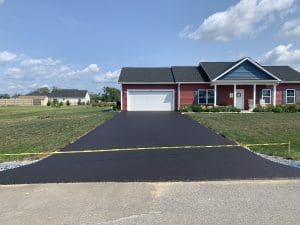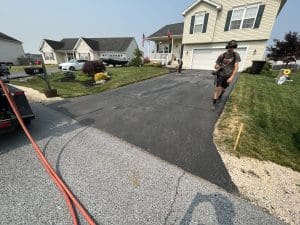The Importance of Proper Asphalt Maintenance: A Year-Round Guide
Asphalt stands as the backbone of our infrastructure, facilitating the smooth and secure movement of vehicles and pedestrians. Upholding its functionality and extending its lifespan demands year-round commitment to proper asphalt maintenance. Familiarizing yourself with asphalt’s composition, the The importance of proper asphalt maintenance, and the economic and safety benefits it offers will empower property owners and municipalities to make informed decisions regarding asphalt care.
Understanding Asphalt and Its Composition
Before delving into the importance of asphalt maintenance, let’s unravel what asphalt is and its composition. Asphalt is a blend of aggregates, including crushed stone and sand, bound together by bitumen—a binder derived from crude oil. This unique combination creates a resilient and flexible material capable of withstanding heavy traffic loads and enduring harsh weather conditions.
Aggregates, being the primary constituents of asphalt, play a pivotal role in its strength and stability. Carefully selected and processed, these aggregates meet stringent criteria for size, shape, and durability. Sourced from quarries, the crushed stone and sand undergo rigorous testing to ensure quality standards are met.
Bitumen, in contrast, serves as the adhesive that binds the aggregates together. It’s a sticky, black, highly viscous substance derived from crude oil. Heated and mixed with aggregates, bitumen forms the asphalt mixture, tightly binding the aggregates to create a cohesive and solid pavement.
The Role of Asphalt in Infrastructure
Asphalt finds extensive use in constructing roadways, parking lots, driveways, and various infrastructure projects, thanks to its remarkable durability and cost-effectiveness. Its ability to endure heavy traffic loads and resist cracking makes it the ideal choice for high-traffic areas. Moreover, asphalt pavements can be swiftly constructed, reducing construction timelines and minimizing disruptions to traffic.
Asphalt’s smooth surface offers drivers a comfortable and enjoyable ride. Its evenness reduces vibrations, improving driver comfort and decreasing vehicle wear and tear, resulting in reduced maintenance costs.
Beyond its functional benefits, asphalt elevates the aesthetics of the surroundings. With its dark hue, asphalt pavements create a visually pleasing contrast against green landscapes and architectural structures, making it a preferred choice for residential driveways, commercial parking lots, and public spaces.
Key Components of Asphalt
The primary components of asphalt encompass aggregates, providing strength and stability, and bitumen, the binding agent. However, there are additional elements that can be incorporated into the asphalt mixture to enhance its performance.
Additives, such as polymers, can be introduced to bolster asphalt’s resistance to cracking. These polymers modify the binder’s properties, rendering it more elastic and flexible, enabling the asphalt pavement to withstand temperature fluctuations and heavy loads without developing cracks.
Modifiers, on the other hand, enhance specific characteristics of asphalt, such as adhesion properties or resistance to aging. These modifiers can be blended into the asphalt mixture to enhance its performance in challenging conditions, like extreme temperatures or heavy rainfall.
In essence, understanding asphalt’s composition and key constituents is essential in recognizing its significance in infrastructure projects. By uniting aggregates and bitumen, asphalt offers a robust, versatile, and cost-effective solution for constructing roads, driveways, and parking lots. Its capacity to endure heavy traffic loads, resist cracking, and enhance aesthetics makes it a favored choice for various applications.
The Importance of Regular Asphalt Maintenance
While asphalt is durable, it’s not immune to damage and deterioration. Neglecting regular maintenance can lead to substantial issues, including cracks, potholes, and uneven surfaces, jeopardizing safety and inflating repair costs.
The Impact of Weather on Asphalt
Weather conditions exert a profound influence on asphalt’s longevity. Winter’s freezing and thawing cycles can induce cracks as water infiltrates the pavement and expands upon freezing. Additionally, sunlight and UV rays exposure lead to binder oxidation and degradation, resulting in brittleness and reduced flexibility. Proper maintenance is pivotal in mitigating weather-related damage.
Preventing Asphalt Damage and Deterioration
Enforcing preventive maintenance measures can minimize the incidence and severity of asphalt damage. Regular cleaning, sealcoating, crack sealing, and pothole repairs are critical in shielding the asphalt surface from water intrusion, UV rays, and other detrimental elements. Timely maintenance not only extends the pavement’s lifespan but also curtails the need for expensive repairs or resurfacing.
Seasonal Considerations for Asphalt Maintenance
Customizing asphalt maintenance practices based on each season’s distinct challenges is imperative to ensure optimal results and preserve asphalt surfaces.
Winter Challenges and Asphalt Care
Cold temperatures, snow, and ice pose unique challenges to asphalt maintenance. Prudent snow removal practices are essential to prevent pavement damage, including using plows equipped with rubber blades and refraining from using sharp objects. The application of de-icing agents should be judicious to minimize potential harm to the asphalt.
In regions experiencing freezing temperatures, crack sealing and patching should be carried out before winter to thwart water infiltration. Routine winter inspections can detect areas of concern, allowing for prompt repairs and ensuring the asphalt remains intact and safe for use.
Summer Maintenance Tips for Asphalt
During the summer months, high temperatures can soften asphalt, rendering it more susceptible to deformation. Regular inspections to identify and repair soft spots or weakened sections are imperative to forestall further damage. Cleaning the surface to remove debris and oil or fuel accumulations contributes to maintaining asphalt’s integrity.
Sealcoating is commonly performed during the summer season as it requires warmer temperatures for proper curing. This protective layer shields asphalt from UV rays, preventing oxidation and extending its lifespan.
The Economic Benefits of Year-Round Asphalt Maintenance
Engaging in comprehensive and year-round asphalt maintenance not only upholds surface functionality and aesthetic appeal but also confers significant economic advantages upon property owners and municipalities.
Cost Savings through Preventive Maintenance
Investing in preventive maintenance, such as crack sealing and sealcoating, is markedly more cost-effective than waiting for extensive damage to ensue. These proactive measures avert water intrusion, which can result in more extensive damage, including potholes and base failure. Regular maintenance diminishes the need for expensive repairs or full resurfacing, thus generating long-term cost savings.
Enhancing Property Value with Pristine Asphalt
Well-maintained asphalt surfaces significantly enhance the overall curb appeal and value of properties. Whether residential, commercial, or municipal, a well-maintained parking lot or roadway leaves a positive impression on visitors and potential buyers. Preserving asphalt in top-notch condition underscores a commitment to quality and professionalism.
Safety Implications of Proper Asphalt Maintenance
Ensuring safe conditions for vehicles and pedestrians is paramount, and proper asphalt maintenance plays a pivotal role in achieving this objective.
Reducing Accident Risks through Regular Maintenance
Potholes, cracks, and uneven surfaces pose substantial hazards for drivers, heightening the risk of accidents. Regular inspections and repairs detect and rectify these issues before they escalate. Maintaining clear and highly visible pavement markings, such as lane lines and crosswalks, further bolsters safety on asphalt surfaces.
Ensuring Pedestrian Safety on Asphalt Surfaces
Smooth and well-maintained asphalt surfaces enhance the safety and comfort of pedestrians. Cracked or damaged pavement can create tripping hazards, particularly for children, the elderly, and individuals with mobility impairments. Swiftly addressing any signs of deterioration and ensuring the proper condition of pedestrian pathways significantly reduces the risk of accidents and injuries.
In conclusion, the importance of proper asphalt maintenance can’t be overstated. Consistent care and preventive actions are essential to safeguard asphalt surfaces from damage wrought by weather, traffic, and other variables. By investing in year-round maintenance, property owners and municipalities can extend their asphalt surfaces’ lifespan, curtail expenses, enhance property value, and guarantee the safety of both vehicles and pedestrians. Trust Top Gun Sealcoating to be your partner in preserving the excellence of asphalt surfaces.




